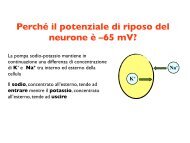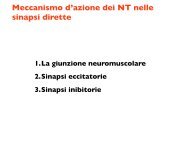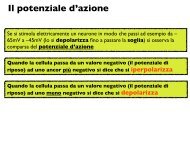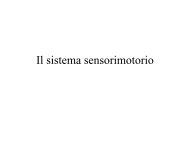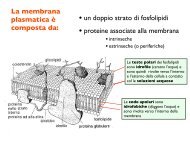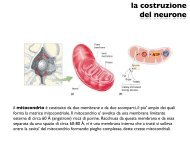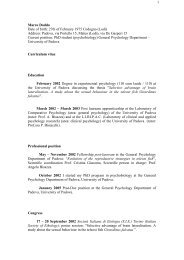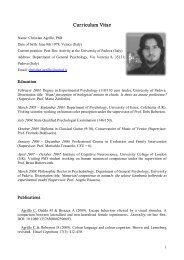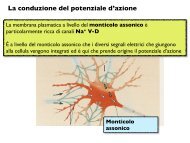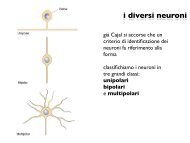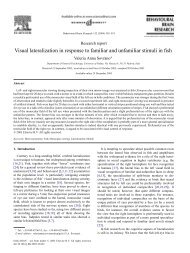Sexual behaviour of immature male eastern mosquitofish: a ... - CPRG
Sexual behaviour of immature male eastern mosquitofish: a ... - CPRG
Sexual behaviour of immature male eastern mosquitofish: a ... - CPRG
You also want an ePaper? Increase the reach of your titles
YUMPU automatically turns print PDFs into web optimized ePapers that Google loves.
Journal <strong>of</strong> Fish Biology (1996) 48, 726–737<br />
<strong>Sexual</strong> <strong>behaviour</strong> <strong>of</strong> <strong>immature</strong> <strong>male</strong> <strong>eastern</strong> mosquit<strong>of</strong>ish:<br />
a way to measure intensity <strong>of</strong> intra-sexual selection?<br />
A. Bisazza*, A. Pilastro†‡, R. Palazzi† and G. Marin†<br />
*Dipartimento di Psicologia Generale, Università di Padova, Piazza Capitaniato 3,<br />
35139 Padova and †Dipartimento di Biologia, Università di Padova, via Trieste 75,<br />
35121 Padova, Italy<br />
(Received 22 November 1994, Accepted 30 June 1995)<br />
Immature <strong>male</strong>s <strong>of</strong> <strong>eastern</strong> mosquit<strong>of</strong>ish Gambusia holbrooki start to be sexually active well<br />
before their copulatory organ (gonopodium) has completely developed and before they become<br />
able to transfer sperm. <strong>Sexual</strong> activity <strong>of</strong> <strong>male</strong>s, consisting <strong>of</strong> copulatory attempts tending to<br />
bypass fe<strong>male</strong> acceptance, is intense (one attempt per minute) and is likely to be energetically<br />
very costly. The sexual <strong>behaviour</strong> <strong>of</strong> <strong>immature</strong> <strong>male</strong>s relative to their maturation stage is<br />
described and tested against two possible adaptive explanations. <strong>Sexual</strong> activity was present in<br />
<strong>male</strong>s from the beginning <strong>of</strong> the development <strong>of</strong> their gonopodium and increased during the<br />
following stages <strong>of</strong> maturation. Two to three weeks before gonopodium development was<br />
completed, sexual activity <strong>of</strong> <strong>immature</strong>s was as high as that <strong>of</strong> adults. Adult <strong>male</strong>s showed<br />
aggressive <strong>behaviour</strong> against a <strong>male</strong> attempting a copulation, irrespective <strong>of</strong> the maturity <strong>of</strong> the<br />
latter. Since previous studies have shown that the reproductive success in this species is<br />
negatively correlated with <strong>male</strong> size when <strong>male</strong>–<strong>male</strong> competition is low (i.e. when the sex ratio<br />
is fe<strong>male</strong> biased), but decreases with <strong>male</strong> size when competition is high, the hypothesis was<br />
tested that sexual activity <strong>of</strong> <strong>immature</strong> <strong>male</strong>s functions as a way to predict their future<br />
reproductive success if they mature at a given size. A second hypothesis tested was that<br />
precocious sexual experience improves the efficiency <strong>of</strong> copulatory attempts. Results were more<br />
in agreement with the first hypothesis, since size at maturity <strong>of</strong> <strong>male</strong>s was influenced by the sex<br />
ratio experienced during maturation and precocious experience gave very little advantage.<br />
1996 The Fisheries Society <strong>of</strong> the British Isles<br />
Key words: Gambusia holbrooki; sexual <strong>behaviour</strong>; <strong>immature</strong> <strong>male</strong>s; aggressive <strong>behaviour</strong>;<br />
sex ratio; experience.<br />
INTRODUCTION<br />
An increasing body <strong>of</strong> evidence indicates that, as assumed by life history theories,<br />
individuals generally pay costs associated with reproduction (Clutton-Brock, 1991;<br />
Marconato, 1991). Selection should therefore favour strategies that reduce costs to<br />
a minimum, and individuals are expected to reproduce only when advantages<br />
exceed costs in terms <strong>of</strong> reduced future fitness. In many bird species, for example,<br />
secondary sexual traits develop only during the breeding season (Andersson, 1983),<br />
or, as in many fish species, breeding coloration is shown or intensified only at the<br />
appearance <strong>of</strong> fe<strong>male</strong>s (e.g. Kodric-Brown, 1983; Gronell, 1989).<br />
An obvious corollary to the above statements is that mating <strong>behaviour</strong> and<br />
manifestations connected with reproduction (territoriality, breeding coloration,<br />
courtship <strong>behaviour</strong>, etc.) should not appear until individuals reach functional<br />
sexual maturity. The rare exceptions known so far have an adaptive explanation.<br />
In several primates, including humans, young infertile individuals<br />
‡Author to whom correspondence should be addressed. Tel.: +39–49–827610; fax: +39–49–8276209;<br />
email: gmarin@civ.bio.unifd.it<br />
726<br />
0022–1112/96/040726+12 $18.00/0 1996 The Fisheries Society <strong>of</strong> the British Isles
sexual <strong>behaviour</strong> <strong>of</strong> <strong>immature</strong> <strong>male</strong> mosquit<strong>of</strong>ish 727<br />
include sexual acts in their play and in some cases a complete coitus is achieved<br />
(Ford & Beach, 1951; Mason, 1965). Among chimpanzee (Pan troglodytes<br />
Blumenbach), young with no previous sexual experience are not immediately able<br />
to copulate successfully, which suggests a possible role for sexual play. In<br />
aquarium studies, <strong>immature</strong> <strong>male</strong>s <strong>of</strong> the <strong>eastern</strong> mosquit<strong>of</strong>ish (Gambusia holbrooki<br />
Girard) exhibit precocious copulatory activity, and their rate <strong>of</strong> copulatory<br />
attempts was comparable to that <strong>of</strong> adults (Bisazza, unpublished data).<br />
Gambusia holbrooki is a small poeciliid fish commonly found in brackish and<br />
fresh waters <strong>of</strong> Italy, where it was introduced from North America at the<br />
beginning <strong>of</strong> this century. Fertilization is internal and the <strong>male</strong> uses its modified<br />
anal fin (gonopodium) to transfer sperm to the fe<strong>male</strong>. As in most poeciliids<br />
(Constantz, 1975; Farr, 1984), <strong>male</strong> sexual activity mainly consists in approaching<br />
the fe<strong>male</strong> from behind, moving the gonopodium forward and trying to<br />
introduce forcibly the gonopodial tip into her genital pore (gonopodial thrusting).<br />
In this species, fe<strong>male</strong>s rarely if ever show receptivity. Males make<br />
copulatory attempts at a very high rate, but only a small proportion <strong>of</strong> them is<br />
successful (Martin, 1975; Bisazza & Marin, 1995). Male mosquit<strong>of</strong>ish, typical <strong>of</strong><br />
most poeciliid species, stop growing when they become sexually mature (Schultz,<br />
1961; Borowsky, 1973a; Zulian, 1990) and body size attained at maturation<br />
changes in response to the social environment (Borowsky, 1973b; Sohn, 1977).<br />
To explain the <strong>behaviour</strong> <strong>of</strong> <strong>immature</strong> <strong>male</strong> mosquit<strong>of</strong>ish, two hypotheses were<br />
proposed. The first one postulates that, as observed in apes and other vertebrates,<br />
experience gained when <strong>immature</strong> increases the efficiency <strong>of</strong> later sexual <strong>behaviour</strong><br />
as adults. The second hypothesis, which will be discussed in more detail later, is<br />
derived from the peculiar reproductive biology <strong>of</strong> this species. The success <strong>of</strong><br />
mating attempts in G. holbrooki is in fact negatively correlated with the <strong>male</strong>’s size<br />
(Bisazza, 1993; Bisazza & Marin, 1995), a relationship observed in other poeciliid<br />
species and possibly a general phenomenon in this family (Farr et al., 1986).<br />
Conversely, both intrasexual selection and fe<strong>male</strong> preference tend to favour the<br />
largest in a group <strong>of</strong> <strong>male</strong>s (Bisazza & Marin, 1991; 1995). Computer simulations<br />
indicate that when <strong>male</strong>s are rare and the encounter rate between them is low,<br />
<strong>male</strong>s should mature at a small size, but when population density is high and the<br />
sex ratio is <strong>male</strong> biased, the influence <strong>of</strong> intra- and intersexual selection increases<br />
and <strong>male</strong>s should delay maturation to attain a large size (Bisazza & Marin, 1995).<br />
It is suggested that by attempting to copulate with fe<strong>male</strong>s, <strong>immature</strong> <strong>male</strong>s gain<br />
information about their probable reproductive success at their present body size,<br />
and accordingly ‘ decide ’ whether to delay maturity or not.<br />
In the first part <strong>of</strong> this paper information is given about the ontogeny <strong>of</strong> <strong>male</strong><br />
sexual <strong>behaviour</strong> and the interactions between adults and <strong>immature</strong> <strong>male</strong>s<br />
described in relation to their developmental stage. In the second part, two<br />
experiments aimed at testing the two explanations for the presence <strong>of</strong> intense<br />
sexual activity in <strong>immature</strong> <strong>male</strong>s are presented.<br />
MATERIALS AND METHODS<br />
EXPERIMENTAL ANIMALS<br />
The individuals used for this work were captured during the breeding season in three<br />
different bodies <strong>of</strong> water <strong>of</strong> Northern Italy. Mostly handnets were used, with a 2·5 mm
728 a. bisazza et al.<br />
mesh that retained specimens <strong>of</strong> every size. Before starting the experiments, individuals<br />
were acclimatized for some days in 130-l. aquaria (stock aquaria), maintained at a<br />
constant photoperiod (illuminated from 06.00 to 20.00 hours) and temperature<br />
(261 C). Fish were fed twice a day with commercial fish food (Tetra Min). For testing<br />
the influence <strong>of</strong> precocious experience on <strong>male</strong> sexual <strong>behaviour</strong> at maturity (Experiment<br />
3), <strong>of</strong>fspring born in captivity to some <strong>of</strong> the wild fe<strong>male</strong>s were used. All individuals to<br />
be used in the experiments were anaesthetized with MS222, sexed and measured to the<br />
nearest 0·5 mm total length (t.l.).<br />
MATURATION STAGES OF MALES<br />
Maturation stage <strong>of</strong> <strong>male</strong>s was determined by examining the development <strong>of</strong> the<br />
gonopodium under a dissecting microscope. Ten stages were identified (Dulzetto, 1931).<br />
Briefly, the development <strong>of</strong> the gonopodium starts with the elongation <strong>of</strong> the 3rd, 4th and<br />
5th rays <strong>of</strong> the anal fin (stage 1 to 4); at stage 5 the length <strong>of</strong> the gonopodium is similar<br />
in length to that <strong>of</strong> mature <strong>male</strong>s, and rays 3 to 5 begin to develop distally bifurcated<br />
articules that, at stages 8 and 9, form a series <strong>of</strong> hooks. At stage 8 the gonopodium can<br />
be turned forward. At stage 9 the gonopodium, previously opaque, becomes transparent.<br />
At stage 10 the distal articles <strong>of</strong> the gonopodium become fused. The maturation <strong>of</strong> the<br />
gonopodium is paralleled by the progressive maturation <strong>of</strong> the testes, which is completed<br />
at stage 9, but <strong>male</strong>s are able to inseminate fe<strong>male</strong>s only at stage 10, when the<br />
gonopodium is completely developed (Dulzetto, 1933).<br />
FREQUENCY OF COPULATORY ATTEMPTS IN IMMATURE MALES<br />
One hundred and forty-six <strong>male</strong>s at different stages <strong>of</strong> sexual maturation were tested.<br />
The day before each test, one <strong>male</strong> was introduced in one <strong>of</strong> six 603636 cm aquaria,<br />
each containing two acclimated adult fe<strong>male</strong>s. Only fe<strong>male</strong>s that had not delivered young<br />
recently were used, because the frequency <strong>of</strong> attempts by <strong>male</strong>s is significantly higher with<br />
post-partum fe<strong>male</strong>s (Bisazza et al., 1989). Each <strong>male</strong> was observed for two periods <strong>of</strong> 10<br />
consecutive minutes, at least 30 min apart, and copulatory attempts were counted. At the<br />
end <strong>of</strong> each test, the <strong>male</strong>s were anaesthetized, measured, and the stage <strong>of</strong> maturation <strong>of</strong><br />
the gonopodium was determined.<br />
FREQUENCY OF AGGRESSIVE BEHAVIOUR OF ADULT RESIDENT MALES<br />
TOWARD IMMATURE MALES<br />
One hundred and thirty-one <strong>male</strong>s in different stages <strong>of</strong> sexual maturation were tested.<br />
Experimental conditions were similar to those <strong>of</strong> above, the only difference being that one<br />
adult <strong>male</strong> (resident) was also present in each experimental aquarium. Thus, each<br />
aquarium contained three adults (one <strong>male</strong> and two fe<strong>male</strong>s). The test <strong>male</strong> (from stage<br />
1 to 10 <strong>of</strong> maturation) was introduced 1 day before being tested. The resident <strong>male</strong> was<br />
always larger than the test <strong>male</strong>. During the two periods <strong>of</strong> observation recordings were<br />
made <strong>of</strong> the number <strong>of</strong> attacks directed by the resident <strong>male</strong> to the test <strong>male</strong>, the number<br />
<strong>of</strong> attacks from the test <strong>male</strong> to the resident, and the number <strong>of</strong> copulatory attempts by<br />
the test <strong>male</strong>. At the end <strong>of</strong> each test, total length and maturation stage were determined<br />
for both <strong>male</strong>s.<br />
EFFECT OF PRECOCIOUS SEXUAL EXPERIENCE ON THE EFFICIENCY OF<br />
MALE COPULATORY BEHAVIOUR<br />
Thirty <strong>male</strong>s were used. Fifteen <strong>of</strong> them were grown from birth to sexual maturity in<br />
130-l. aquaria containing adult fe<strong>male</strong>s (experienced <strong>male</strong>s). The other 15 <strong>male</strong>s were<br />
grown in similar aquaria, but adult fe<strong>male</strong>s were not present (naïve <strong>male</strong>s).<br />
Upon reaching sexual maturity, each <strong>male</strong> was tested in aquaria (707036 cm)<br />
containing four adult fe<strong>male</strong>s. Observations started 1 min after the <strong>male</strong> was introduced,<br />
and continued for 30 min. Since the success <strong>of</strong> the copulatory attempts depends strongly<br />
on the ratio <strong>of</strong> <strong>male</strong> to fe<strong>male</strong> length (Bisazza & Marin, 1991), the four fe<strong>male</strong>s in the<br />
experimental aquaria were similar in size, and the <strong>male</strong> to fe<strong>male</strong> length ratio was kept as
sexual <strong>behaviour</strong> <strong>of</strong> <strong>immature</strong> <strong>male</strong> mosquit<strong>of</strong>ish 729<br />
constant as possible. Copulatory attempts and successful gonopodial thrusts (observed<br />
contact between gonopodium and fe<strong>male</strong> genital pore) were recorded for each <strong>male</strong> <strong>of</strong> the<br />
two groups. As a measure <strong>of</strong> the efficiency <strong>of</strong> the copulation <strong>behaviour</strong> <strong>of</strong> a <strong>male</strong>, the<br />
ratio between successful gonopodial thrusts and total number <strong>of</strong> copulatory attempts was<br />
calculated.<br />
EFFECT OF THE SEX-RATIO EXPERIENCED BY IMMATURE MALES ON<br />
THEIR SIZE AT MATURITY<br />
The effect <strong>of</strong> the sex ratio on <strong>male</strong> size at maturation was tested using 36 <strong>immature</strong><br />
<strong>male</strong>s (stage 1–2), 72 adult <strong>male</strong>s and 90 adult fe<strong>male</strong>s. The experimental aquaria were<br />
707036 cm in dimension. The natural habitat <strong>of</strong> G. holbrooki is characterized by the<br />
presence <strong>of</strong> dense vegetation. Aquaria were therefore subdivided into six sections, using<br />
vertical partitions, in order to simulate the complexity <strong>of</strong> a natural situation. Partitions<br />
allowed fish to move freely from one compartment to any other. Food was provided<br />
twice a day ad libitum. One <strong>immature</strong> <strong>male</strong> (stage 1 or 2) and two adult <strong>male</strong>s, whose size<br />
exceeded by 40·5 and 70·5 mm that <strong>of</strong> the <strong>immature</strong> <strong>male</strong>, were introduced to each<br />
aquarium. To simulate two situations with different sex ratios, one adult fe<strong>male</strong> was<br />
introduced in some <strong>of</strong> the aquaria (adult <strong>male</strong> : fe<strong>male</strong> ratio=2 : 1, 19 replicates), and<br />
four adult fe<strong>male</strong>s in the rest <strong>of</strong> the aquaria (sex ratio 1 : 2, 17 replicates). Total length<br />
<strong>of</strong> <strong>male</strong>s was measured before the beginning <strong>of</strong> the experiment by using a microscope<br />
with a micrometric ocular. Specimens were observed under the microscope in a Petri dish<br />
filled with water, thus avoiding anaesthetizing <strong>male</strong>s before the experiment. 15 days after<br />
the <strong>immature</strong> <strong>male</strong> matured, it was removed from the aquarium, its total length was<br />
measured and its maturation stage assessed as previously described.<br />
The aquaria used for these experiments did not allow the continuous observation <strong>of</strong> the<br />
<strong>male</strong>s’ <strong>behaviour</strong>. To measure the frequency <strong>of</strong> aggressive and sexual interactions<br />
between <strong>immature</strong> <strong>male</strong>s and adult <strong>male</strong>s, and between <strong>immature</strong> <strong>male</strong>s and fe<strong>male</strong>s,<br />
similar aquaria were used in the middle <strong>of</strong> a dimly-lit room. Twenty-eight replicates were<br />
run (14 with one fe<strong>male</strong> and 14 with four fe<strong>male</strong>s), using <strong>immature</strong> <strong>male</strong>s at stages 5 and<br />
6 <strong>of</strong> gonopodium maturation. For each replicate, <strong>immature</strong>s were kept under observation<br />
for 30 min a day (three periods <strong>of</strong> 10 min, 10 to 15 min apart from each other), for<br />
three consecutive days. Attacks by adult <strong>male</strong>s towards <strong>immature</strong>, attacks by the<br />
<strong>immature</strong> towards the adults, and gonopodial thrusts attempted by the <strong>immature</strong> were<br />
scored, and the fraction <strong>of</strong> time that the <strong>immature</strong> spent in sectors <strong>of</strong> the aquarium where<br />
one or two adult <strong>male</strong>s were also present were measured.<br />
STATISTICAL ANALYSIS<br />
All variables were normally distributed and parametric tests were used. When variance<br />
was not homogeneous between groups, data were logarithmically transformed. Proportional<br />
data were arcsin-root transformed. Statistics were computed with the SPSS/PC<br />
statistical package.<br />
RESULTS<br />
FREQUENCY OF COPULATORY ATTEMPTS IN IMMATURE MALES (Table I)<br />
The size <strong>of</strong> <strong>male</strong>s was significantly different between groups (ANOVA,<br />
F=17·7; d.f.=9, 145; P
730 a. bisazza et al.<br />
Table I. Frequency <strong>of</strong> copulatory attempts by <strong>male</strong>s and total<br />
body length (means.d.) at different stages <strong>of</strong> gonopodial<br />
maturation. Maturation stages are defined according to Dulzetto<br />
(1931)<br />
Gonopodium<br />
maturation<br />
stage<br />
No. <strong>of</strong><br />
individuals<br />
Total length<br />
(mm)<br />
Copulatory<br />
attempts<br />
1 11 21·215·21 1·72 3·19<br />
2 19 23·816·43 2·10 2·88<br />
3 13 25·113·09 6·84 7·55<br />
4 18 25·116·52 8·44 7·22<br />
5 15 27·017·97 12·13 6·79<br />
6 8 27·813·87 18·00 7·63<br />
7 10 27·313·98 24·4011·57<br />
8 9 28·218·39 22·77 8·91<br />
9 24 27·625·08 26·4515·28<br />
10 19 26·620·87 33·3615·27<br />
Table II. Frequency <strong>of</strong> aggression (means.d.) by adult <strong>male</strong>s towards <strong>immature</strong> <strong>male</strong>s<br />
at different stages <strong>of</strong> gonopodial maturation and total body length (T.L.) (means.d.)<br />
Gonopodium<br />
maturation<br />
stage<br />
Number <strong>of</strong><br />
individuals<br />
T.L. <strong>of</strong> adults<br />
(mm)<br />
T.L. <strong>of</strong> <strong>immature</strong>s<br />
(mm)<br />
Aggression<br />
frequency<br />
1 13 28·924·65 20·514·21 3·00 7·14<br />
2 16 28·115·75 23·715·80 11·1824·00<br />
3 13 28·318·98 25·012·82 13·8419·46<br />
4 17 29·020·90 25·119·58 25·7029·14<br />
5 12 29·922·44 26·615·82 21·0822·62<br />
6 10 29·711·84 27·513·63 20·6014·44<br />
7 9 29·425·17 26·515·70 52·8827·96<br />
8 8 28·920·77 28·019·82 48·3724·23<br />
9 14 28·420·86 26·916·77 44·2835·85<br />
10 19 28·212·62 25·618·78 49·1538·41<br />
The frequency <strong>of</strong> copulatory attempts differed significantly between stages<br />
(ANOVA, F=34·3; d.f.=9, 145; P
sexual <strong>behaviour</strong> <strong>of</strong> <strong>immature</strong> <strong>male</strong> mosquit<strong>of</strong>ish 731<br />
Table III. Effect <strong>of</strong> precocious sexual experience on the efficiency <strong>of</strong> copulatory attempts<br />
<strong>of</strong> adult <strong>male</strong>s (mean numbers.d.)<br />
n<br />
Ratio between<br />
<strong>male</strong> T.L. and<br />
fe<strong>male</strong>s T.L.<br />
(mm)<br />
Copulatory<br />
attempts<br />
Successful<br />
copulatory<br />
attempts<br />
Frequency <strong>of</strong><br />
successful<br />
copulatory<br />
attempts<br />
(%)<br />
Naïve <strong>male</strong>s 15 0·620·039 136·4626·53 7·263·71 5·492·8<br />
Experienced <strong>male</strong>s 15 0·630·040 75·7333·95 4·061·33 6·012·5<br />
d.f.=9, 130; P
No. <strong>of</strong><br />
fe<strong>male</strong>s<br />
Successful copulatory attempts (%)<br />
10<br />
7.5<br />
5.0<br />
2.5<br />
0.0<br />
0–10 min<br />
P < 0.05 N.S. N.S. N.S.<br />
10–20 min<br />
20–30 min<br />
Fig. 1. Frequency <strong>of</strong> successful gonopodial thrusts (mean with 1 s.d.) <strong>of</strong> <strong>male</strong>s with precocious sexual<br />
experience () compared with that <strong>of</strong> <strong>male</strong>s grown in the absence <strong>of</strong> fe<strong>male</strong>s ().<br />
Table IV. Effect <strong>of</strong> sex ratio during <strong>male</strong> development on the body size (means.d.)<br />
No. <strong>of</strong><br />
<strong>immature</strong>s<br />
tested<br />
T.L. <strong>of</strong> adults (mm) T.L. <strong>of</strong> <strong>immature</strong> (mm) Total length<br />
increase<br />
Large <strong>male</strong> Small <strong>male</strong> Stage 1 to 2 Stage 10 (%)<br />
1 19 24·852·66 22·122·05 17·482·08 25·862·21 49·418·8<br />
4 16 25·002·51 21·781·47 17·681·57 23·951·57 35·912·9<br />
Table V. Mean number (s.d.) <strong>of</strong> aggressive interactions with adult <strong>male</strong>s, <strong>of</strong> copulatory attempts,<br />
and <strong>of</strong> time spent in the same sector where at least an adult <strong>male</strong> was also present for <strong>immature</strong> <strong>male</strong>s<br />
in different sex ratio conditions<br />
Adult<br />
sex ratio<br />
M:F<br />
732 a. bisazza et al.<br />
No. <strong>of</strong><br />
fe<strong>male</strong>s<br />
No. <strong>of</strong><br />
replicates<br />
Attacks by<br />
adults<br />
EFFECT OF THE SEX RATIO EXPERIENCED BY IMMATURE MALES ON<br />
THEIR SIZE AT MATURITY (Tables IV and V)<br />
Immature <strong>male</strong>s that grew in aquaria with a low sex ratio increased on average<br />
their body size at maturation by about 35% <strong>of</strong> their original size. Males that<br />
grew in aquaria with a high sex ratio increased their size by about 50%; the<br />
Total<br />
Aggressive interactions Time spent<br />
Attacks by<br />
<strong>immature</strong><br />
Total<br />
with adult<br />
<strong>male</strong>(s)<br />
Copulatory<br />
attempts<br />
2 : 1 1 19 41·726·4 6·211·5 47·924·0 26·410·2 3·6 5·2<br />
1 : 2 4 16 37·923·3 8·713·9 46·626·6 20·710·1 13·111·7<br />
Immature <strong>male</strong>s used for this experiment were at stages 5 and 6 <strong>of</strong> their gonopodium maturation.
sexual <strong>behaviour</strong> <strong>of</strong> <strong>immature</strong> <strong>male</strong> mosquit<strong>of</strong>ish 733<br />
difference between the groups was highly significant (t=2·84, n=35, P
734 a. bisazza et al.<br />
1982), and probably suffer high mortality. Indirect evidence for these costs has<br />
been found by Krumholz (1963) in populations <strong>of</strong> Gambusia manni (Hubbs). He<br />
found that populations living in habitats with a high density <strong>of</strong> predators had a<br />
sex ratio biased towards fe<strong>male</strong>s, and a low mean size <strong>of</strong> adult <strong>male</strong>s, compared<br />
to those observed in populations living in habitats with low predator density.<br />
Among the possible adaptive explanations is the ‘ training ’ hypothesis.<br />
Copulatory experience during the stages preceding maturation may enhance the<br />
copulatory efficiency <strong>of</strong> <strong>male</strong>s. As far as we know, in fish there are no examples<br />
<strong>of</strong> experience enhancing performance. However, it is known that young threespined<br />
sticklebacks (Gasterosteus aculeatus L.) fed in the laboratory with live<br />
prey are more efficient foragers when they become adults than individuals fed<br />
with frozen food (Ibrahim & Huntingford, 1992). Our results do not seem to<br />
support an analogous explanation for copulatory activity. In fact, mosquit<strong>of</strong>ish<br />
<strong>male</strong>s with precocious experience were more efficient in their copulatory attempts<br />
than <strong>male</strong>s grown in aquaria where fe<strong>male</strong>s were not present, but only in the first<br />
10 min after meeting a fe<strong>male</strong>. Later on, naïve <strong>male</strong>s were as efficient as<br />
experienced <strong>male</strong>s. It seems therefore unlikely that <strong>immature</strong> <strong>male</strong>s are sexually<br />
so active for weeks in order to get trained, if after a few minutes <strong>of</strong> copulatory<br />
attempts naïve <strong>male</strong>s become capable <strong>of</strong> normal sexual <strong>behaviour</strong>.<br />
The other possible explanation tested is that <strong>immature</strong> <strong>male</strong>s, through an<br />
intense sexual activity, gain information about the probable reproductive success<br />
they would attain by maturing at their actual size. As in most poeciliid species,<br />
<strong>male</strong> mosquit<strong>of</strong>ish stop growing or grow little after reaching sexual maturity, but<br />
considerable variation in this trait is generally found within populations.<br />
Previous studies indicate that in G. holbrooki the success <strong>of</strong> copulatory attempts<br />
is inversely related to <strong>male</strong> size when competition is absent (Bisazza, 1993;<br />
Bisazza & Marin, 1995). On the contrary, when sex ratio is biased towards<br />
<strong>male</strong>s, larger <strong>male</strong>s monopolize fe<strong>male</strong>s and keep subordinate <strong>male</strong>s far from<br />
fe<strong>male</strong>s (Bisazza & Marin, 1991). The reproductive success <strong>of</strong> <strong>male</strong>s therefore<br />
depends critically on the size at which they mature in relation to the social<br />
environment: at low population densities and when the sex ratio is biased<br />
towards fe<strong>male</strong>s, <strong>male</strong>s are expected to mature at a small size, and vice versa, as<br />
shown by computer simulations and field study (Bisazza & Marin, 1995; Zulian<br />
et al., 1995). In natural populations, the proportion <strong>of</strong> <strong>male</strong>s and population<br />
density usually increase from the beginning <strong>of</strong> the breeding season onwards.<br />
None the less, there are frequent large variations both between and within<br />
populations in different years (Zulian, 1990). A simple rule <strong>of</strong> thumb, e.g.<br />
mature small at the beginning <strong>of</strong> the breeding season and at a larger size later on,<br />
would not be very efficient.<br />
Immature <strong>male</strong>s that are able to test their potential reproductive success and<br />
consequently ‘ decide ’ whether to mature or to keep growing, would therefore be<br />
favoured. The present results seem to support this hypothesis: the size attained<br />
at maturity by <strong>male</strong>s is influenced by the frequency <strong>of</strong> sexual interactions with<br />
fe<strong>male</strong>s. Social control <strong>of</strong> body size at maturity is a well known phenomenon in<br />
poeciliids. It has been shown that the frequency <strong>of</strong> aggressive interactions with<br />
adult <strong>male</strong>s influences the size <strong>of</strong> sexual maturation <strong>of</strong> <strong>male</strong>s in other poeciliid<br />
species (Borowsky, 1973b; Sohn, 1977; Farr, 1980), as well as in G. holbrooki<br />
(Zulian et al., 1993). In the present experiments, the frequency <strong>of</strong> aggression by
sexual <strong>behaviour</strong> <strong>of</strong> <strong>immature</strong> <strong>male</strong> mosquit<strong>of</strong>ish 735<br />
adult <strong>male</strong>s did not change signficantly between treatments (with one or four<br />
adult fe<strong>male</strong>s). None the less, the body size attained at maturation by <strong>male</strong>s was<br />
negatively correlated with the frequency <strong>of</strong> copulatory attempts, that, in turn,<br />
depended on the sex ratio in the aquarium where they grew. These results<br />
therefore suggest that social control mechanisms, at least in G. holbrooki, may be<br />
more complicated, and perhaps more precise, than previously thought. In fact,<br />
it could be argued that, for a maturing <strong>male</strong>, aggressive <strong>behaviour</strong> by adult <strong>male</strong>s<br />
may not be a precise measure <strong>of</strong> his possible reproductive success. During the<br />
breeding season, adult <strong>male</strong>s spend most <strong>of</strong> their time around fe<strong>male</strong>s, attempting<br />
to copulate or trying to keep other <strong>male</strong>s away from them (McPeek, 1992;<br />
Bisazza & Marin, 1995). For this reason, the best way for an <strong>immature</strong> <strong>male</strong> to<br />
test his potential reproductive success is by trying to copulate with fe<strong>male</strong>s, and<br />
by gaining information about copulations attempted, frequency <strong>of</strong> successful<br />
copulations and <strong>of</strong> attacks received. Preliminary studies (Bisazza, unpublished<br />
data) suggest that <strong>immature</strong> <strong>male</strong>s also show sexual <strong>behaviour</strong> in other<br />
poeciliids. In three species, Belonesox belizanus (Kner), Girardinus falcatus<br />
(Eigenmann) and Phalloceros caudimaculatus (Hensel), sexual <strong>behaviour</strong> was<br />
observed at an early stage <strong>of</strong> gonopodium development. Conversely, in Poecilia<br />
reticulata (Peters) and in Heterandria formosa (Agassiz) <strong>male</strong>s started to be<br />
sexually active from 5 to 10 days after the gonopodium was completely<br />
developed. Histological examination <strong>of</strong> the gonads showed that mature sperms<br />
were present in P. reticulata and in H. formosa, but not in G. falcatus and<br />
P. caudimaculatus. Interestingly, body size is the major factor determining the<br />
outcome <strong>of</strong> <strong>male</strong> contests in G. holbrooki and in the other four species that we<br />
found to have precocious sexual <strong>behaviour</strong> (Bisazza & Marin, 1995), but not in<br />
the two species lacking it (Kodric-Brown, 1983; Zannini, 1994).<br />
We would like to thank A. Kodric-Brown for helpful suggestions to a previous version<br />
<strong>of</strong> the manuscript. This research was partially supported by a MURST 60% grant to<br />
A. Bisazza.<br />
References<br />
Andersson, M. (1983). On the functions <strong>of</strong> conspicuous seasonal plumages in birds.<br />
Animal Behaviour 31, 1262–1264.<br />
Andrew, R. J. (1966). Precocious adult <strong>behaviour</strong> in the young chick. Animal Behaviour<br />
14, 485–500.<br />
Andrew, R. J. (1975). Effects <strong>of</strong> testosterone on the <strong>behaviour</strong> <strong>of</strong> the domestic chick. II.<br />
Effects present in <strong>male</strong>s but not in fe<strong>male</strong>s. Animal Behaviour 23, 139–155.<br />
Bisazza, A. (1993). Male competition, fe<strong>male</strong> mate choice and sexual size dimorphism in<br />
poeciliid fishes. Marine Behaviour and Physiology 23, 257–286.<br />
Bisazza, A., Marconato, A. & Marin, G. (1989). Male mate preferences in the<br />
mosquit<strong>of</strong>ish Gambusia holbrooki. Ethology 83, 335–343.<br />
Bisazza, A. & Marin, G. (1991). Male size and fe<strong>male</strong> mate choice in the <strong>eastern</strong><br />
mosquit<strong>of</strong>ish (Gambusia holbrooki: Poeciliidae). Copeia 1991, 730–735.<br />
Bisazza, A. & Marin, G. (1995). <strong>Sexual</strong> selection and sexual size dimorphism in the<br />
<strong>eastern</strong> mosquit<strong>of</strong>ish Gambusia holbrooki (Pisces: Poeciliidae). Ethology, Ecology<br />
and Evolution 7, 169–183.<br />
Borowsky, R. L. (1973a). Relative size and the development <strong>of</strong> fin coloration in<br />
Xiphophorus variatus. Physiological Zoology 46, 22–28.<br />
Borowsky, R. L. (1973b). Social control <strong>of</strong> adult size in <strong>male</strong>s Xiphophorus variatus.<br />
Nature 245, 332–335.
736 a. bisazza et al.<br />
Clutton-Brock, T. H. (1991). The Evolution <strong>of</strong> Parental Care. Princeton, NJ: Princeton<br />
University Press.<br />
Constantz, G. D. (1975). Behavioural ecology <strong>of</strong> mating in the <strong>male</strong> Gila topminnow,<br />
Poeciliopsis occidentalis (Cyprinodontiformes: Poeciliidae). Ecology 56, 966–973.<br />
Dulzetto, F. (1931). Sviluppo e struttura del gonopodio di Gambusia holbrooki. Pubblicazioni<br />
della Stazione Zoologica di Napoli 11, 1–85.<br />
Dulzetto, F. (1933). La struttura del testicolo di Gambusia holbrooki (GRD) e la sua<br />
evoluzione in rapporto con lo sviluppo del gonopodio. Archivio Zoologico Italiano<br />
19, 405–431.<br />
Endler, J. A. (1982). Convergent and divergent effects <strong>of</strong> natural selection on colour<br />
patterns in two fish faunas. Evolution 36, 178–188.<br />
Farr, J. A. (1980). The effect <strong>of</strong> juvenile social interaction on growth rate, size and age<br />
at maturity, and adult social <strong>behaviour</strong> in Girardinus metallicus Poey (Pisces:<br />
Poeciliidae). Zeitschrift für Tierpsychologie 52, 247–268.<br />
Farr, J. A. (1984). Premating <strong>behaviour</strong> in the subgenus Limia (Pisces: Poeciliidae):<br />
sexual selection and the evolution <strong>of</strong> courtship. Zeitschrift für Tierpsychologie 65,<br />
152–165.<br />
Farr, J. A., Travis, J. & Trexler, J. C. (1986). Behavioural allometry and interdemic<br />
variation in sexual <strong>behaviour</strong> <strong>of</strong> the sailfin molly, Poecilia latipinna (Pisces:<br />
Poeciliidae). Animal Behaviour 34, 497–509.<br />
Ford, C. S. & Beach, F. A. (1951). Patterns <strong>of</strong> <strong>Sexual</strong> Behaviour. New York: Harper &<br />
Brothers.<br />
Gronell, A. M. (1989). Visiting <strong>behaviour</strong> by fe<strong>male</strong>s <strong>of</strong> the sexually dichromatic<br />
damselfish, Chrysiptera cyanea (Teleostei: Pomacentridae): a probable method <strong>of</strong><br />
assessing <strong>male</strong> quality. Ethology 81, 89–122.<br />
Ibrahim, A. A. & Huntingford, F. A. (1992). Experience <strong>of</strong> natural prey and feeding<br />
efficiency in three-spined sticklebacks (Gasterosteus aculeatus L.). Journal <strong>of</strong> Fish<br />
Biology 41, 619–l625.<br />
Kodric-Brown, A. (1983). Determinants <strong>of</strong> <strong>male</strong> reproductive success in pupfish<br />
(Cyprinodon peconensis). Animal Behaviour 31, 128–137.<br />
Krumholz, L. A. (1963). Relationships between fertility, sex ratio, and exposure to<br />
predation in populations <strong>of</strong> the mosquit<strong>of</strong>ish Gambusia manni Hubbs at Bimini,<br />
Bahamas. Internationale Revue der gesamten Hydrobiologie 48, 201–256.<br />
Liley, N. R. & Seghers, B. H. (1975). Factors affecting the morphology and <strong>behaviour</strong><br />
<strong>of</strong> guppies in Trinidad. In Function and Evolution in Behaviour (Baerends,<br />
G. B., Beer, C. & Manning, A., eds), pp. 92–118. Oxford: Oxford University<br />
Press.<br />
Marconato, A. (1991). Life history tactics and population structure in freshwater fish<br />
species. In Form and Function and Zoology (Lanzavecchia, G. & Valvassori,<br />
R., eds). Selected Symposia and Monographs U.Z.I., pp. 379–393. Modena:<br />
Mucchi.<br />
Martin, R. G. (1975). <strong>Sexual</strong> and aggressive behavior, density and social structure in a<br />
natural population <strong>of</strong> mosquit<strong>of</strong>ish, Gambusia affinis holbrooki. Copeia 1975,<br />
445–454.<br />
Mason, W. A. (1965). The social development <strong>of</strong> monkeys and apes. In Primate<br />
Behavior, Field Studies <strong>of</strong> Monkeys and Apes (DeVore, I., ed.), pp. 514–543. New<br />
York: Holt, Rinehart & Winston.<br />
McPeek, M. A. (1992). Mechanisms <strong>of</strong> sexual selection operating on body size in the<br />
mosquit<strong>of</strong>ish (Gambusia holbrooki). Behavioural Ecology 3, 1–12.<br />
Schultz, R. J. (1961). Reproductive mechanisms <strong>of</strong> unisexual and bisexual strains <strong>of</strong> the<br />
viviparous fish Poeciliopsis. Evolution 15, 302–325.<br />
Sohn, J. J. (1977). Socially induced inhibition <strong>of</strong> genetically determined maturation in the<br />
platyfish, Xiphophorus maculatus. Science 195, 199–201.<br />
Stone, C. P. (1940). Precocious copulatory activity induced in <strong>male</strong> rats by subcutaneous<br />
injections <strong>of</strong> testosterone propionate. Endocrinology 26, 511–515.<br />
Zannini, L. (1994). Selezione sessuale e dimorfismo sessuale nei pecilidi. Doctoral<br />
Thesis, University <strong>of</strong> Padova.
sexual <strong>behaviour</strong> <strong>of</strong> <strong>immature</strong> <strong>male</strong> mosquit<strong>of</strong>ish 737<br />
Zulian, E. (1990). Selezione e dimensioni nei maschi di Gambusia holbrooki (Pisces:<br />
Poeciliidae). Analisi dei meccanismi che determinano la lunghezza alla maturita.<br />
PhD Thesis, University <strong>of</strong> Padova.<br />
Zulian, E., Bisazza, A. & Marin, G. (1993). Determinants <strong>of</strong> size in <strong>male</strong> <strong>eastern</strong><br />
mosquit<strong>of</strong>ish (Gambusia holbrooki): Inheritance and plasticity <strong>of</strong> a sexual selected<br />
character. Bollettino di Zoologia 60, 317–322.<br />
Zulian, E., Bisazza, A. & Marin, G. (1995). Variations <strong>of</strong> <strong>male</strong> body size in natural<br />
populations <strong>of</strong> Gambusia holbrooki. Ethology, Ecology and Evolution 7, 1–10.




